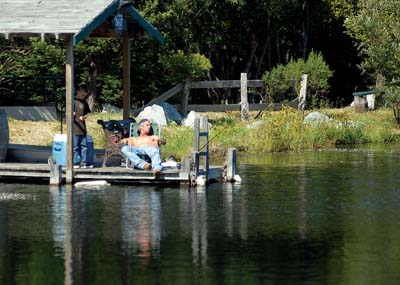Looking for a better source of water three years ago, Randy
McAlpine went drilling. Searching deep under the soil, in October
2007 the owner of McAlpine Lake, an area used for fishing and
camping, near San Juan Bautista drilled more than 1,000 feet deep
before he ran into a
”
gold mine
”
of water, and the water is sparkling clean.
Looking for a better source of water three years ago, Randy McAlpine went drilling.
Searching deep under the soil, in October 2007 the owner of McAlpine Lake, an area used for fishing and camping, near San Juan Bautista drilled more than 1,000 feet deep before he ran into a “gold mine” of water, and the water is sparkling clean.
Straight from its source, the water is clear and blue. It’s so clean, the McAlpines don’t need to put anything in it. The water is pure, said Randy McAlpine’s wife Melanie.
And the difference between this new water source and the county’s San Felipe imported water is dramatic.
Randy McAlpine, who developed the man-made lake in 1999, said the county’s water had an odor and it wasn’t clean.
“It came a time where the water wasn’t very good,” he said. “It had an odor to it and I decided to get another well.”
The new well went deeper into the county’s surface than any other well in the area, he said. From that source came the sparkling water that fills the lake. For nearly three years, the McAlpines pulled the water – the original source is unclear and the federal government called it “ancient” – with no restrictions from the county.
That changed recently when McAlpine found out he was part of District 6, where no matter the source, the county charges landowners for pulling water from the ground.
From the county’s perspective, all water in the ground of District 6 belongs to the county, said Jeff Cattaneo, the manager of San Benito County Water District.
On Tuesday, Randy McAlpine met with Cattaneo to discuss why McAlpine must pay for pulling water from a source he discovered.
“It’s not a big deal,” McAlpine said. “We are talking about a small amount of money.”
In District 6, all land owners have access to the “blue valve” San Felipe water that the water district supplies but the district’s law, which was voted on and passed, stipulates that all residents inside must pay a fee for drilling a well.
The fee is $22.50 per acre-foot for a business that is considered municipal or industrial and only $2.50 per acre-foot if the water is used for agricultural purposes.
That’s something McAlpine was unaware of when he first drilled, he said.
“I knew there would be some sort of pumping fee but certainly something different than 20 something dollars,” he said.
Currently, McAlpine pulls 10 to 12 acre-feet per month from the well, but that number can vary.
McAlpine has contested to the county that the water was on his property and was separate from the county’s source, he said. The water was protected by “impenetrable” blue clay for more than a million years before he drilled into the source, he said.
The United States Geological Survey agreed the water had been protected for a long time, McAlpine said, noting how the USGS called the water “heavy and ancient.”
See the full story in the Pinnacle on Friday.










